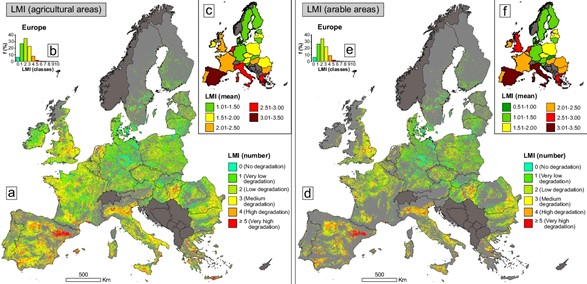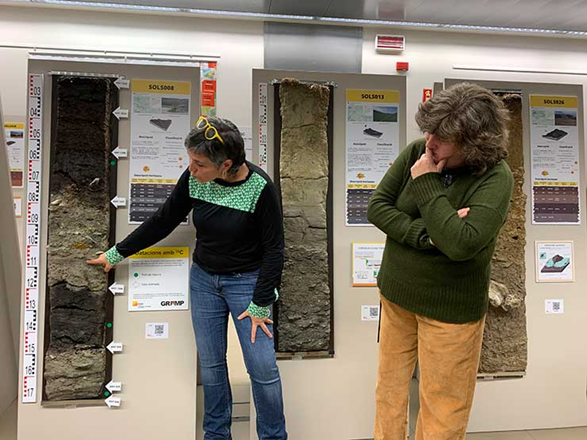COMBATING MULTIPLE SOIL DEGRADATION IN THE PYRENEES
Soil degradation is a complex socio-environmental threat, which generally manifests itself through multiple simultaneous mechanisms that remain largely unexplored in Europe. The journal Nature very recently published an unprecedented study of the multi-degradation of European agricultural and arable land in 40 countries, listing twelve threats affecting soil health. The databases were used to model the ways in which soil degradation factors converge and combine, and ultimately to construct a multifactorial European soil degradation index (LMI). The results are clear.
Since the OPCC, we felt it was important to share the results of this research and extract information about the Pyrenean bioregion. As the researchers write, ‘these results will enable policy makers to develop knowledge-based strategies to mitigate soil degradation and achieve other key European sustainable development objectives’. This research provides a fertile basis for the work currently being carried out in the Pyrenees, and opens the way for European soil protection and conservation projects to flourish.
Here are a few key points:
European soils ‘multi-degraded’ by human activities
Using a synergistic approach, the study examines the co-occurrence (simultaneous presence) of five major degradation processes (water erosion, soil salinisation, loss of soil organic carbon, vegetation degradation and aridity). According to the recent mission report ‘A Soil Deal for Europe’, it is estimated that 60-70% of all EU soils are in poor health due to current management practices, pollution, urbanisation and the effects of climate change. The EU has placed the need for healthy soils at the heart of the European Green Deal in order to achieve climate neutrality, zero pollution, sustainable food supplies and a resilient environment.
Pesticide and heavy metal pollution is identified as one of the most important factors, as the researchers note: ‘the results revealed that pesticide soil pollution has the largest spatial footprint at continental level’, accounting for almost 52% of the agricultural area of the countries studied, a percentage equivalent to 1.1 million km2. France is one of the countries most affected by this type of pollution.
"The hot spot in terms of percentage of simultaneous processes is Spain."
It would appear that there are many soil degradation factors affecting a single area. Spain is by far the country most affected by these co-occurrence phenomena: ‘the hotspot in terms of percentage of simultaneous processes (LMI classes 4 and 5 combined, where 4 or even 5 factors are expressed simultaneously) is Spain (~30% of the national agricultural area)’. Aridity, desertification and soil degradation due to anthropogenic climate change are Iberian constants. It should be pointed out here that unlike desertification (desertificación), which is a natural process of desert expansion due mainly to geomorphological and climatic causes, desertización is a complex process of land degradation in arid, semi-arid and dry sub-humid areas, due to multiple factors, in which human action has a large share of responsibility. Increasing desertización involves the gradual disappearance of fertile topsoil, resulting in land that is less and less productive. This is certainly a reality on a peninsular scale, but it is much less present and perceptible in the Pyrenean bioregion. The findings for north-east Spain, the region corresponding to Catalonia and the Mediterranean coast, are more alarming: the soils in this area combine five different degradation factors at significant levels (process combination I: Water Erosion + Soil Pollution via Pesticides + Soil Pollution via Heavy Metals + Groundwater Decline + Aridity). These analyses still have significant limitations, such as the omission of many important specific processes and the mixing of various biophysical and socio-economic factors in soil degradation, such as tourist pressure on mountain trails.

© Prăvălie, R., Borrelli, P., Panagos, P. et al. A unifying modelling of multiple land degradation pathways in Europe. Nat Commun 15, 3862 (2024). https://doi.org/10.1038/s41467-024-48252-x
Description: a Spatial distribution of LMI values (number of co-occurring processes) in agricultural landscapes. b Histogram of LMI values for European agricultural land. c Mean number of co-occurring processes in agricultural environments in continental countries. d Spatial distribution of LMI values in arable landscapes. e Histogram of LMI values for European arable land. f Mean number of co-occurring processes in arable environments in continental countries.
LMI stands for Land Multi-degradation Index. Light grey highlights non-agricultural/non-arable land, while dark grey indicates countries (masked) with incomplete data (9-10 input layers out of 12) for LMI modelling.
SOLPYR, the Pyrenees' commitment to soil protection
Once again, scientific evidence is calling for swift (re)action to preserve a resource vital to our food supply, water storage and purification, water risk management, habitat preservation and biodiversity, among many other ecosystem services provided by soils. As stated, ‘a multiple modelling approach to soil degradation is essential in Europe. This approach may prove crucial for the application of various measures relating to agriculture, climate and sustainable development’. Following on from this study, the work being carried out by the Institut Cartogràfic i Geològic de Catalunya (ICGC), the OPCC and partners in the Interreg POCTEFA SOLPYR project will generate the first map of Pyrenean soils and draw up a cross-border action plan for the conservation and protection of the massif's soils. Climate change and the pressure exerted by mountain activities have a direct impact on soil health, and the Pyrenees are far from being spared. The first SOLPYR meeting took place in Tremp on 29 and 30 April, where the various partners were able to exchange working methods and carry out soil surveys, which are essential for understanding the problems specific to Pyrenean soils.

Romane Baze
Sources:
Prăvălie, R., Borrelli, P., Panagos, P. et al. A unifying modelling of multiple land degradation pathways in Europe. Nature Commun 15, 3862 (2024). https://doi.org/10.1038/s41467-024-48252-x
Moreau, Z., “Pesticides, aridité, métaux lourds, érosion… Les sols agricoles européens sont “multi-dégradés”, Dossier Biodiversité, publié le 11 mai 2024, Libération. Article consulté le 13 mai 2024.
Los enlaces de la vida (blog), “¿Cuál es la diferencia entre desertización y desertificación?”. Disponible aquí: https://losenlacesdelavida.fundaciondescubre.es/que-es-la-biodiversidad/preguntas/cual-es-la-diferencia-entre-desertizacion-y-desertificacion/
PYRENEAN CLIMATE CHANGE OBSERVATORY
Avenida Nuestra Señora de la Victoria, 8
22.700 - Jaca
Huesca - España
+34 974 36 31 00
info_opcc@ctp.org





